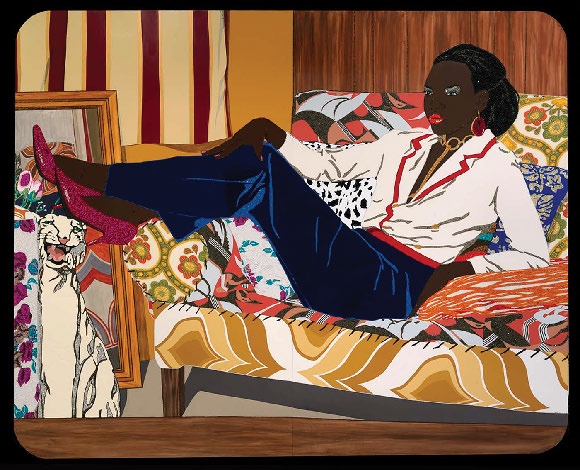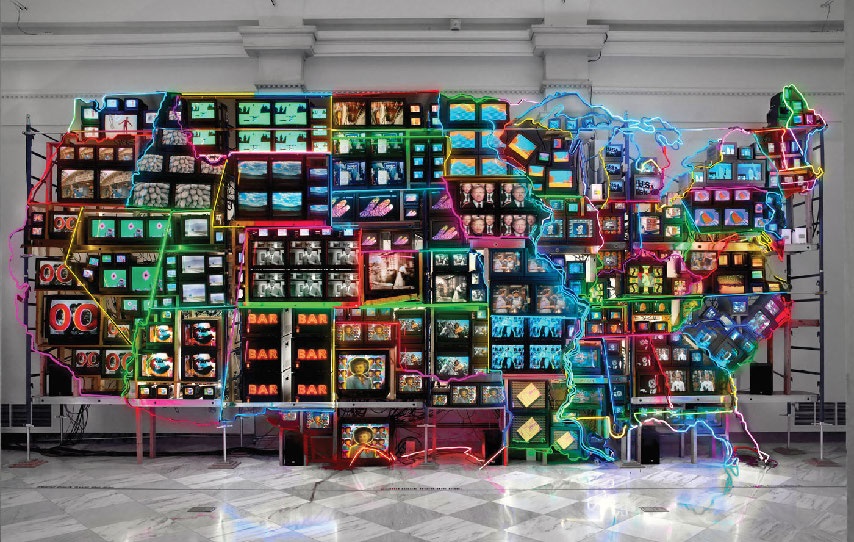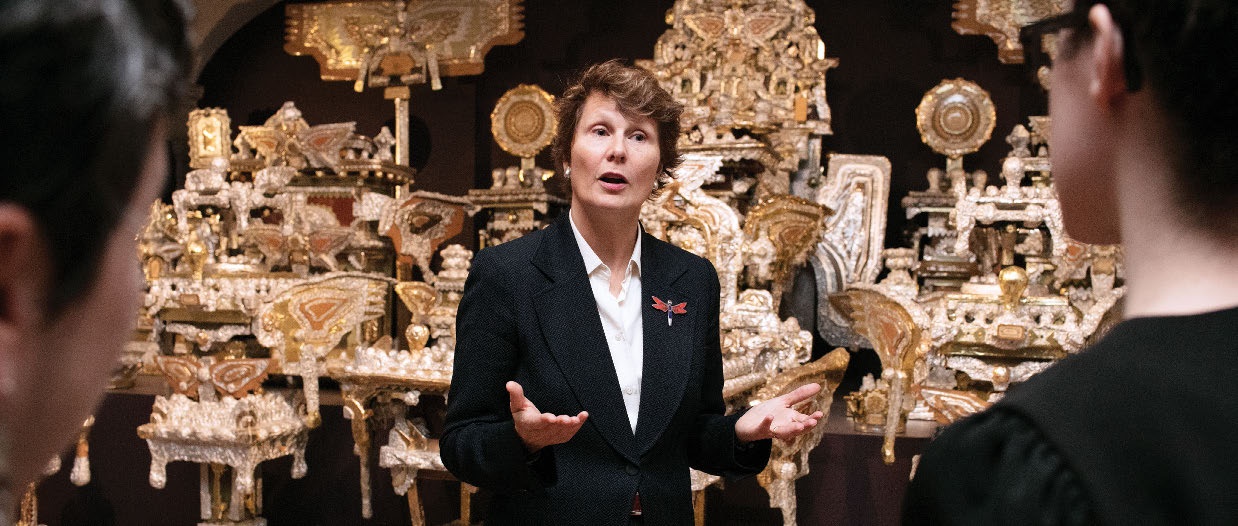Stephanie Stebich ’88 boldly steps into her new role as a Smithsonian director.
Columbia College | Columbia University in the City of New York
Stephanie Stebich ’88 boldly steps into her new role as a Smithsonian director.

JÖRG MEYER
This route had not been the plan. When I met Stebich (her full title is The Margaret and Terry Stent Director of the Smithsonian American Art Museum and the Renwick Gallery) in September for an early morning tour, we were waylaid from our carefully pre-selected path by our photographer’s interest in outrageous and eye-catching works; Stebich gamely changed direction. The ease with which she unspooled stories at these unexpected stops points to how quickly she’s become familiar with the works in her care.
The museum’s director as of April 3, Stebich is passionate about making the Washington, D.C., institution a destination for art lovers and neophytes alike. Her role is varied — hiring curators and staff, raising funds and managing donor relations, keeping the museum running and creating a cohesive experience for visitors. The common threads are a love of art and a deep knowledge built on a long, country-crossing career: “As I look back — and forward — in my career, what type of museums have I been attracted to?” she asks. “I’m a civic art museum kind of girl; my museums have the name of the city in them: Brooklyn, Cleveland, Minneapolis, Tacoma. Now I’ve got the nation to serve.”

Portrait of Mnonja, 2010
Mickalene Thomas
Smithsonian American Art Museum, museum purchase through the Luisita L. and Franz H. Denghausen Endowment.
© 2010 Mickalene Thomas
Stebich comes to the Smithsonian from Washington State’s Tacoma Art Museum (TAM), a mid-sized museum known for its comprehensive Western and Northwestern art collections. During her 12 years there she made significant changes, raising $37 million in a capital campaign — $20 million beyond the goal — and adding more than 2,000 works to the collection. She also was instrumental in acquiring the Haub Family Collection, which in 2012 brought more than 300 works of Western American art to the museum, solidifying its position as a leader in Western American art. “Stephanie is a force of nature,” says Laura Fry, the former Haub Curator of Western American Art at TAM. “She is one of the most driven people I’ve met; she will have a vision and will work tirelessly to execute it. Her leadership was what really made the Tacoma Art Museum.”
At SAAM, Stebich is eager to continue taking risks and pushing things forward. “I like to say I inherited well,” she says of assuming the role vacated by Betsy Broun, who had held the position since 1989. Six months into the job when we first spoke, Stebich already had big plans, envisioning two new curator positions, one to focus on media art and one for
African-American art; developing a strategic collecting plan focused on filling gaps in the museum’s collection (she mentioned starting with the minimalism movement); and building out digital interactive resources for guests. She was also excitedly prepping for “No Spectators: The Art of Burning Man,” which will bring the ephemeral, large-scale nature of the Nevada desert festival to the Renwick Gallery of the Smithsonian American Art Museum, with immersive pieces built exclusively for the space. It’s scheduled to be on display beginning in March. Stebich had attended the West Coast festival in the past and was eager to share its aesthetic with a new audience.
“My challenge is to remind people that there is a vast country beyond the Eastern Seaboard that we need to be in conversation with, and we need to reflect [those areas’] creativity, inspirations and aspirations,” Stebich says.
Born in Germany and raised in Scarsdale, N.Y., the daughter of an art historian and a businessman, Stebich says that becoming a museum director was an obvious choice — “a happy combination of the business of museums and the joy of being with works of art.”
Still, although Stebich knew from an early age that she wanted to work in the arts, she credits the College for giving her the background to make it happen. “I’m going to posit that Columbia is the best place to study art history; when you ask what my extracurricular was, it was New York City,” she says. “If you think about being an undergraduate, particularly in the field of art history, your resources are unparalleled — you’ve got unbelievable faculty who are involved in the cultural life of the city, you’ve got these amazing resources … And of course, you were one bus or subway ride away from all these fabulous museums.”

Electronic Superhighway: Continental U.S., Alaska, Hawaii, 1995
Nam June Paik
Smithsonian American Art Museum, gift of the artist.
© Nam June Paik Estate
After graduation Stebich had a fellowship at the Guggenheim and an assistantship at the Brooklyn Museum. “It was an exciting time,” she says of New York in the late ’80s. “I was a member of the Women’s Action Coalition and I thought, ‘When I become a museum director, I want to make sure women are better represented in all that we do.’ Being in the second class of women at the College made that visible to me — that it was a privilege to go there, that this was a different moment.”
Stebich’s work in civic art museums across the country has well prepared her for being SAAM’s director. As the assistant director of the Cleveland Museum of Art, where she worked from 1995 to 2001, she coordinated a major facilities renovation and headed the renovation’s architect selection, which she describes as “a fascinating process of planning for new spaces and dreaming of who could imagine [them].” At the Minneapolis Institute of Art, where she was assistant director from 2001 to 2004, she co-led a $500,000 project to link staff and databases to better serve museum visitors; she was also responsible for visitor services, public programs and special events, and interactive media.
In Tacoma, Stebich grew the museum as a community resource. In 2005 she launched the Día de los Muertos Free Community Festival, which initially welcomed 400 visitors; by 2016 it had more than 4,000 visitors a day. She takes pride in presenting what she calls “provocative and important exhibitions,” such as “Hide/Seek: Difference and Desire in American Portraiture,” which explored the fluidity of sexuality and gender in modern America portraiture; the exhibit caused controversy and protests in D.C. and Brooklyn before she brought it to TAM.
“Stephanie wasn’t afraid to have the museum take some risks with the content we presented and what we were willing to do,” Fry says. “She was very nimble and forward-thinking in many ways and let the Tacoma Art Museum have a presence and a significance that most museums that size do not. I admired her ability to make bold decisions, to set a direction and not play it safe.”

Stebich in front of The Throne of the Third Heaven of the Nations’ Millennium General Assembly, ca. 1950–1964
James Hampton
Jörg Meyer; Smithsonian American Art Museum, gift of anonymous donors
Her time at these varied museums has put Stebich in touch with the pulse of American art and given her a firsthand look at the diversity of the United States. “Civic art museums reflect the cities and communities in which they sit. They are democratic, welcoming and collaborative in spirit,” she says. “Their collections and programs reflect the local histories and communities.” Now Stebich is ready to take that city-centric focus national.
Standing in front of Nam June Paik’s Electronic Superhighway: Continental U.S., Alaska, Hawaii — a riot of color and sound with neon tubes highlighting film and TV clips looping on a 40-foot map of the U.S. — it’s easy to get lost in the work as media blares and bright lights trace familiar paths along state lines. Stebich points out that such a daring piece “invites you to look.” And it’s her job to make sure guests have plenty of American art to keep looking at. “We want people to see us as their favorite Smithsonian, the one they want to bring people to, that they think of when they think about the American experience and American identity,” she says.
Stebich’s museum draws many local visitors (she says that 53 percent of visitors are repeats) and she wants to make sure that residents of what she calls “the DMV” (D.C., Maryland, Virginia) continue to be as thrilled by the museum as visitors from further reaches. “I think that’s a great testimony to people falling in love with this museum, having their favorites that they visit again and again, and also trusting us to do interesting and surprising exhibitions and stay fresh and relevant,” she says. Going forward, the goal is to cultivate “a sense of wonder” for both new and returning guests. To that end, the museum hosts live music nights in the galleries, film screenings and lecture series, and encourages locals to spend time in the stunning Kogod Courtyard, a 28,000-square-foot open space with a glass ceiling at the entrance of SAAM.
We end our tour at the Galleries for Folk and Self-Taught Art, home to the showstopper The Throne of the Third Heaven of the Nations’ Millennium General Assembly by James Hampton. The kaleidoscopic, multi-level piece is huge, with altars and thrones meticulously crafted from cardboard, plastic and found objects covered in metallics. Above it all, sculpted in foil are the words “FEAR NOT.”
As we pause to take it in, Stebich says, “‘Fear not’ — how’s that for a mantra in life? I always like to think ‘Fear not; art will save you.’”
To hear more from Stebich, check out CCT's Feature Extra for a look at the works from the originally planned tour.

Published three times a year by Columbia College for alumni, students, faculty, parents and friends.
Columbia Alumni Center
622 W. 113th St., MC 4530, 6th Fl.
New York, NY 10025
212-851-7852
cct@columbia.edu

Columbia Alumni Center
622 W. 113th St., MC 4530, 4th Fl.
New York, NY 10025
212-851-7488
ccalumni@columbia.edu